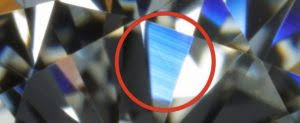When the polish of the diamond is not good it affects the brilliancy, the fire and especially the luster of the stone.
There are 3 defects that can affect the polish of the diamond:
- Polish Lines – These are very thin, crowded and transparent parallel lines that go in the polish direction of the stone, and that never cross facets.

- Burnt areas – White matte (sometimes brown or gray) areas on the surface of the stone.

- Scratches and Abrasions.
You should always look for polish lines and burnt areas from the area of the stone opposite to where they are. This means that to see polish lines and burnt areas in the pavilion, one must look through the crown, and to see polish lines and burnt areas in the crown, one must look through the pavilion.
Polish lines and burnt areas can be easily fixed by repolishing the stone. You should send the diamond back to the polishing factory and repolish it. The diamond hardly lose any weight during this process.
Rules for determining the polish grade
- If there are no polish problems the grade is: Excellent.
- If there are few scratches or polish lines the grade is: Very Good.
- If there is a medium amount of scratches or a medium amount of polish lines or very light burnt areas the grade will be: Good.
- If there are burnt areas that are easily seen by the Loupe the grade will be: Fair.
Would you like to learn more about diamonds? You can approach the Center of Gemological Studies and register to the most prestige, affluent and respected gemology course in the Israeli Diamond Center.
Hadas Dori Bar Moshe also lectures about diamonds in her lecture: The Secrets of the Diamonds.


